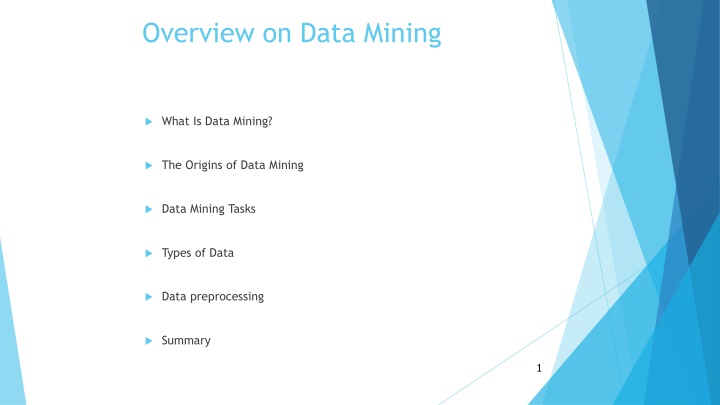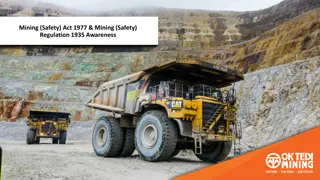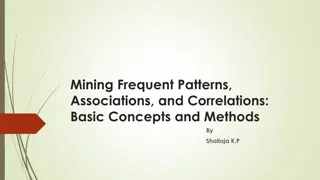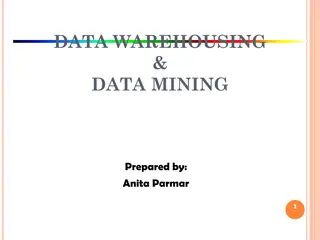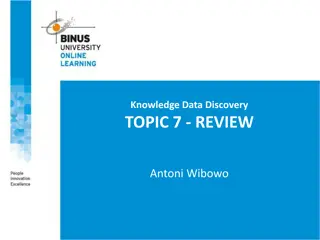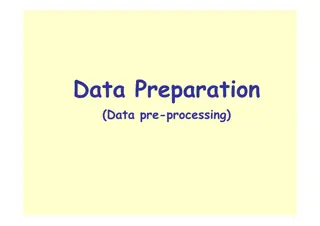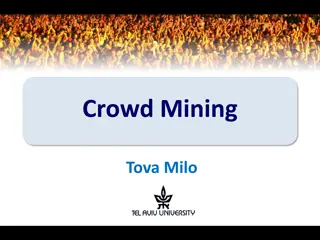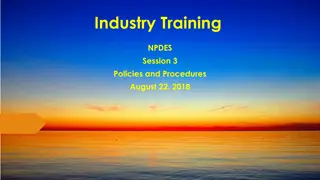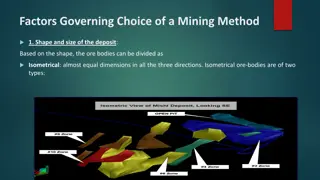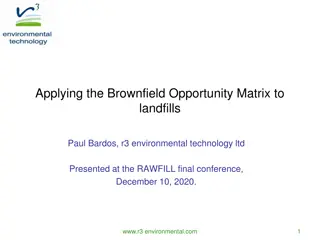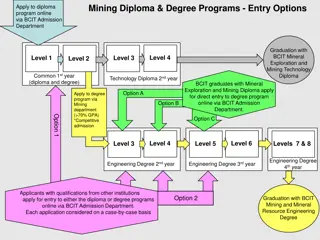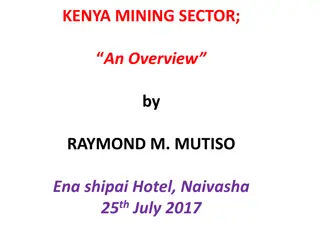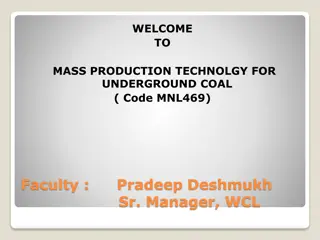Overview on Data Mining: What Is Data Mining? The Origins of Data Mining
Data mining, or knowledge discovery from data, involves extracting valuable patterns and knowledge from vast datasets. This overview delves into the origins of data mining, its tasks, and the importance of uncovering insights from rich but underutilized data sources.
Download Presentation

Please find below an Image/Link to download the presentation.
The content on the website is provided AS IS for your information and personal use only. It may not be sold, licensed, or shared on other websites without obtaining consent from the author.If you encounter any issues during the download, it is possible that the publisher has removed the file from their server.
You are allowed to download the files provided on this website for personal or commercial use, subject to the condition that they are used lawfully. All files are the property of their respective owners.
The content on the website is provided AS IS for your information and personal use only. It may not be sold, licensed, or shared on other websites without obtaining consent from the author.
E N D
Presentation Transcript
Overview on Data Mining What Is Data Mining? The Origins of Data Mining Data Mining Tasks Types of Data Data preprocessing Summary 1
What Is Data Mining? Data mining (knowledge discovery from data) Extraction of interesting (non-trivial, implicit, previously unknown and potentially useful) patterns or knowledge from huge amount of data Or in short Search for Valuable Information in Large Volumes of Data Alternative names Knowledge discovery (mining) in databases (KDD), knowledge extraction, data/pattern analysis, data archeology, data dredging, information harvesting, business intelligence, etc. 2
Why Data Mining We have rich data. data rich But we have poor knowledge. knowledge poor
The Origins of Data Mining Machine learning Database Statistics Data Mining Artificial Intelligence
The Origins of Data Mining 1989 IJCAI Workshop on Knowledge Discovery in Databases Knowledge Discovery in Databases (G. Piatetsky-Shapiro and W. Frawley, 1991) 1991-1994 Workshops on Knowledge Discovery in Databases Advances in Knowledge Discovery and Data Mining (U. Fayyad, G. Piatetsky- Shapiro, P. Smyth, and R. Uthurusamy, 1996) 1995-1998 International Conferences on Knowledge Discovery in Databases and Data Mining (KDD 95-98) Journal of Data Mining and Knowledge Discovery (1997) ACM SIGKDD conferences since 1998 and SIGKDD Explorations More conferences on data mining PAKDD (1997), PKDD (1997), SIAM-Data Mining (2001), (IEEE) ICDM (2001), WSDM (2008), etc. 5 ACM Transactions on KDD (2007)
Conferences and Journals on Data Mining KDD Conferences Other related conferences ACM SIGKDD Int. Conf. on Knowledge Discovery in Databases and Data Mining (KDD) DB conferences: ACM SIGMOD, VLDB, ICDE, EDBT, ICDT, Web and IR conferences: WWW, SIGIR, WSDM SIAM Data Mining Conf. (SDM) ML conferences: ICML, NIPS (IEEE) Int. Conf. on Data Mining (ICDM) PR conferences: CVPR, Journals European Conf. on Machine Learning and Principles and practices of Knowledge Discovery and Data Mining (ECML-PKDD) Data Mining and Knowledge Discovery (DAMI or DMKD) IEEE Trans. On Knowledge and Data Eng. (TKDE) Pacific-Asia Conf. on Knowledge Discovery and Data Mining (PAKDD) KDD Explorations ACM Trans. on KDD Int. Conf. on Web Search and Data Mining (WSDM) 6
Where to Find References? DBLP, CiteSeer, Google Data mining and KDD (SIGKDD: CDROM) Conferences: ACM-SIGKDD, IEEE-ICDM, SIAM-DM, PKDD, PAKDD, etc. Journal: Data Mining and Knowledge Discovery, KDD Explorations, ACM TKDD Database systems (SIGMOD: ACM SIGMOD Anthology CD ROM) Conferences: ACM-SIGMOD, ACM-PODS, VLDB, IEEE-ICDE, EDBT, ICDT, DASFAA Journals: IEEE-TKDE, ACM-TODS/TOIS, JIIS, J. ACM, VLDB J., Info. Sys., etc. AI & Machine Learning Conferences: Machine learning (ML), AAAI, IJCAI, COLT (Learning Theory), CVPR, NIPS, etc. Journals: Machine Learning, Artificial Intelligence, Knowledge and Information Systems, IEEE-PAMI, etc. Web and IR Conferences: SIGIR, WWW, CIKM, etc. Journals: WWW: Internet and Web Information Systems, Statistics Conferences: Joint Stat. Meeting, etc. Journals: Annals of statistics, etc. Visualization Conference proceedings: CHI, ACM-SIGGraph, etc. Journals: IEEE Trans. visualization and computer graphics, etc. 7
Recommended Reference Books E. Alpaydin. Introduction to Machine Learning, 2nd ed., MIT Press, 2011 S. Chakrabarti. Mining the Web: Statistical Analysis of Hypertex and Semi-Structured Data. Morgan Kaufmann, 2002 R. O. Duda, P. E. Hart, and D. G. Stork, Pattern Classification, 2ed., Wiley-Interscience, 2000 T. Dasu and T. Johnson. Exploratory Data Mining and Data Cleaning. John Wiley & Sons, 2003 U. M. Fayyad, G. Piatetsky-Shapiro, P. Smyth, and R. Uthurusamy. Advances in Knowledge Discovery and Data Mining. AAAI/MIT Press, 1996 U. Fayyad, G. Grinstein, and A. Wierse, Information Visualization in Data Mining and Knowledge Discovery, Morgan Kaufmann, 2001 J. Han, M. Kamber, and J. Pei, Data Mining: Concepts and Techniques. Morgan Kaufmann, 3rd ed. , 2011 T. Hastie, R. Tibshirani, and J. Friedman, The Elements of Statistical Learning: Data Mining, Inference, and Prediction, 2nd ed., Springer, 2009 B. Liu, Web Data Mining, Springer 2006 T. M. Mitchell, Machine Learning, McGraw Hill, 1997 Y. Sun and J. Han, Mining Heterogeneous Information Networks, Morgan & Claypool, 2012 P.-N. Tan, M. Steinbach and V. Kumar, Introduction to Data Mining, Wiley, 2005 S. M. Weiss and N. Indurkhya, Predictive Data Mining, Morgan Kaufmann, 1998 I. H. Witten and E. Frank, Data Mining: Practical Machine Learning Tools and Techniques with Java Implementations, Morgan Kaufmann, 2nd ed. 2005 8
Data Mining Tasks Predictive Tasks Use some variables to predict unknown or future values of other variables. Descriptive Tasks Find human-interpretable patterns that describe the data. 9
Data Mining Tasks Association and Correlation Analysis Classification Cluster Analysis Outlier Analysis
Association and Correlation Analysis Frequent patterns (or frequent itemsets) What kinds of goods are usually bought in your Target? Association, correlation vs. causality A typical association rule Diaper Beer [0.5%, 75%] (support, confidence) What is the relationship between strongly associated items and strongly correlated? How to mine such patterns and rules efficiently in large datasets? How to use such patterns for classification, clustering, and other applications?
Classification Classification and label prediction Construct models (functions) based on some training examples Describe and distinguish classes or concepts for future prediction E.g., classify countries based on (climate), or classify cars based on (gas mileage) Predict some unknown class labels Typical methods Decision trees, na ve Bayesian classification, support vector machines, neural networks, rule-based classification, pattern- based classification, logistic regression, Typical applications: Credit card fraud detection, direct marketing, classifying stars, diseases, web-pages, 12
Cluster Analysis Unsupervised learning (i.e., Class label is unknown) Group data to form new categories (i.e., clusters), e.g., cluster houses to find distribution patterns Principle: Maximizing intra-class similarity & minimizing interclass similarity Many methods and applications 13
Outlier Analysis Outlier analysis Outlier: A data object that does not comply with the general behavior of the data Noise or exception? One person s garbage could be another person s treasure Methods: by product of clustering or regression analysis, Useful in fraud detection, rare events analysis 14
Types Of Data Data to be mined Database data (extended-relational, object-oriented, heterogeneous, legacy), data warehouse, transactional data, stream, spatiotemporal, time-series, sequences, text and web, multi-media, graphs & social and information networks Knowledge to be mined (or: Data mining functions) Characterization, discrimination, association, classification, clustering, trend/deviation, outlier analysis, etc. Descriptive vs. predictive data mining Multiple/integrated functions and mining at multiple levels Techniques utilized Data-intensive, data warehouse (OLAP), machine learning, statistics, pattern recognition, visualization, high-performance, etc. Applications adapted Retail, telecommunication, banking, fraud analysis, bio-data mining, stock market analysis, text mining, Web mining, etc. 15
Types of Data Database-oriented data sets and applications Relational database, data warehouse, transactional database Object-relational databases, Heterogeneous databases and legacy databases Advanced data sets and advanced applications Data streams and sensor data Time-series data, temporal data, sequence data (incl. bio-sequences) Structure data, graphs, social networks and information networks Spatial data and spatiotemporal data Multimedia database Text databases The World-Wide Web 16
Time and Ordering: Sequential Pattern, Trend and Evolution Analysis Sequence, trend and evolution analysis Trend, time-series, and deviation analysis: e.g., regression and value prediction Sequential pattern mining e.g., first buy digital camera, then buy large SD memory cards Periodicity analysis Motifs and biological sequence analysis Approximate and consecutive motifs Similarity-based analysis Mining data streams Ordered, time-varying, potentially infinite, data streams 17
Types of Data Sets Record Relational records, e.g., network connection records Data matrix, e.g., numerical matrix, crosstabs timeout season coach game score team ball lost pla wi n y Document data: text documents: term-frequency vector Transaction data Document 1 3 0 5 0 2 6 0 2 0 2 Graph and network World Wide Web Document 2 0 7 0 2 1 0 0 3 0 0 Social or information networks Document 3 0 1 0 0 1 2 2 0 3 0 Molecular Structures Ordered Video data: sequence of images TID 1 2 3 4 5 Items Bread, Coke, Milk Beer, Bread Beer, Coke, Diaper, Milk Beer, Bread, Diaper, Milk Coke, Diaper, Milk Temporal data: time-series Sequential Data: transaction sequences, system call sequences Genetic sequence data Spatial, image and multimedia: Spatial data: maps Image data: 18 Video data:
Important Characteristics of Structured Data Dimensionality Curse of dimensionality Sparsity Only presence counts Resolution Patterns depend on the scale Distribution Centrality and dispersion 19
Data Objects Data sets are made up of data objects. A data object represents an entity. Examples: sales database: customers, store items, sales medical database: patients, treatments university database: students, professors, courses Also called samples , examples, instances, data points, objects, tuples. Data objects are described by attributes. Database rows -> data objects; columns ->attributes. 20
Attributes Attribute (or dimensions, features, variables): a data field, representing a characteristic or feature of a data object. E.g., customer _ID, name, address Types: Nominal Binary Numeric: quantitative Interval-scaled Ratio-scaled 21
Attribute Types Nominal:categories, states, or names of things Hair_color = {auburn, black, blond, brown, grey, red, white} marital status, occupation, ID numbers, zip codes Binary Nominal attribute with only 2 states (0 and 1) Symmetric binary: both outcomes equally important e.g., gender Asymmetric binary: outcomes not equally important. e.g., medical test (positive vs. negative) Convention: assign 1 to most important outcome (e.g., HIV positive) Ordinal Values have a meaningful order (ranking) but magnitude between successive values is not known. Size = {small, medium, large}, grades, army rankings 22
Numeric Attribute Types Quantity (integer or real-valued) Interval Measured on a scale of equal-sized units Values have order E.g., temperature in C or F , calendar dates No true zero-point Ratio Inherent zero-point We can speak of values as being an order of magnitude larger than the unit of measurement (10 K is twice as high as 5 K ). e.g., temperature in Kelvin, length, counts, monetary quantities 23
Discrete vs. Continuous Attributes DiscreteAttribute Has only a finite or countably infinite set of values E.g., zip codes, profession, or the set of words in a collection of documents Sometimes, represented as integer variables Note: Binary attributes are a special case of discrete attributes ContinuousAttribute Has real numbers as attribute values E.g., temperature, height, or weight Practically, real values can only be measured and represented using a finite number of digits Continuous attributes are typically represented as floating-point variables 24
Data Quality: Why Preprocess the Data? Measures for data quality: A multidimensional view Accuracy: correct or wrong, accurate or not Completeness: not recorded, unavailable, Consistency: some modified but some not, dangling, Timeliness: timely update? Believability: how trustable the data are correct? Interpretability: how easily the data can be understood? 25
Tasks of Data Preprocessing Data cleaning Fill in missing values, smooth noisy data, identify or remove outliers, and resolve inconsistencies Data integration Integration of multiple databases, data cubes, or files Data reduction Dimensionality reduction Numerosity reduction Data compression Data transformation and data discretization Normalization Concept hierarchy generation 26
Reference www.cs.uiuc.edu/homes/hanj/cs412/bk3_slides/01Intro.ppt UIUC cs412 by Prof. Jiawei Han
